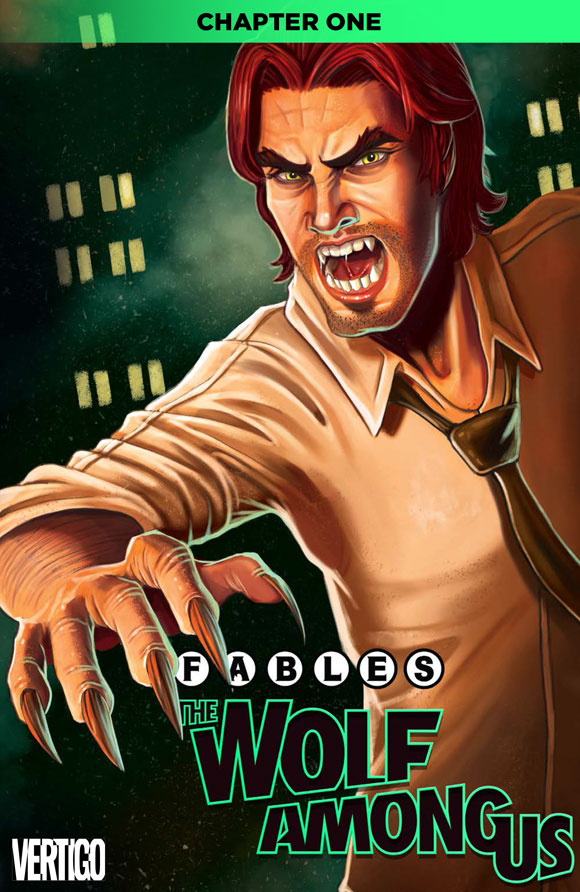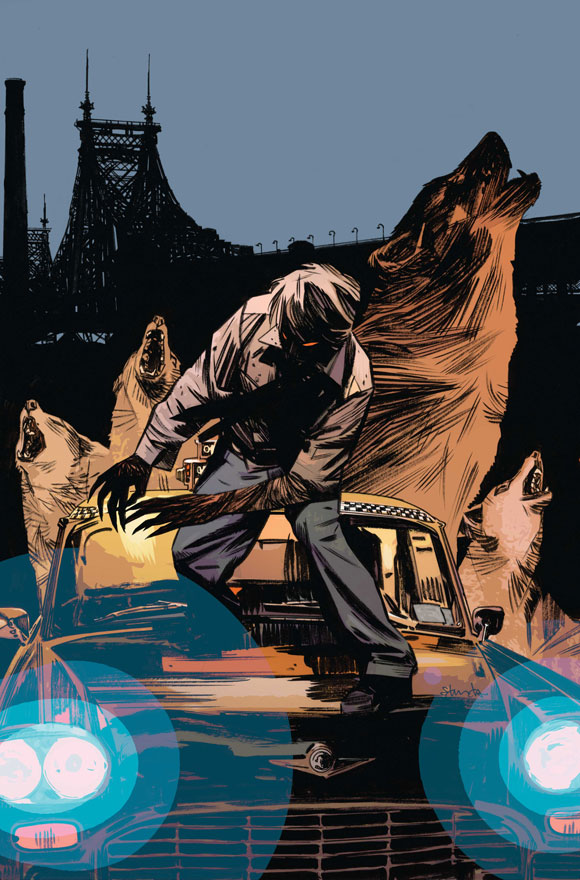In the twelve years since its debut, Fables has expanded from a bestselling monthly comic book to become a franchise as robust as any other in comics. Snow White, Bigby Wolf, Rose Red and the rest of the Fabletown crew have appeared in multiple comic book spinoffs, crossovers, novels, graphic novels, fan conventions and recently, an acclaimed video game from Telltale Games. However, they’re about to enter a world that even the globetrotting Cinderella has yet to experience: the weekly world of digital first comics.
FABLES: THE WOLF AMONG US #1 is the first chapter in a brand new digital series that not only represents Fables’ first digital first venture, but that of Vertigo as well. Based on the Telltale video game of the same name, Fables: The Wolf Among Us is set before the monthly Fables comic, years before Bigby’s marriage to Snow and Fabletown’s struggles with the Adversary. It focuses, as the title would imply, on Bigby as he tracks down a serial killer who’s targeting Fables. Written by Matthew Sturges (who’s no stranger to the world of Fables) and David Justus and drawn by a rotating team of talented artists that include Shawn McManus, Travis Moore and cover artist Christina Anna Zullo, Fables: The World Among Us promises to be a weekly walk on the darker side of Fabletown.
We were curious about this exciting new series, so we asked Sturges and Justus to answer a few questions of ours. They kindly agreed, and fortunately for us, didn’t wolf out once.

Fables: The Wolf Among Us #1 cover art by Christina Anna Zullo
Fables: The Wolf Among Us is based on a game, but it’s set within the Fables universe. How familiar do readers have to be with Fables to understand it? Would you say it’s new reader friendly?
David Justus: Matt and I have done everything in our power to make this a story that anyone could pick up, whether they’d been reading Fables for years, or only knew about it from playing the video game, or were totally unfamiliar with these characters outside of old fairy tales. The beauty, incidentally, of working with folks from folklore is that you’re never quite at square one with readers; even if someone’s never heard of Bigby Wolf, they’re familiar with the idea of the Big Bad Wolf, so they’re bringing a sketchy outline that we then get to fill in with the details we need them to know for our purposes.
And I feel like we’ve done a good job of giving just enough detail to intrigue, not so much as to overload. We’ll hold your hand just long enough to make sure you’re headed down the right darkened alleyway. The ideal reaction from any new reader, of course, is to see them back again for the next issue. Here, though, we’re able to extend a much grander invitation: If you enjoy this, there are hundreds more stories set in this universe. Even if we’re your first, I can’t imagine we’ll be your last.
Matthew Sturges: I cannot recommend Jack of Fables strongly enough, if you’re looking for another one. Just throwing that out there.
Matthew, you’ve worked in the Fables universe before. Were you glad for a chance to return to it?
MS: Of course. When Bill Willingham asked me to write a couple of backups for the last few Fables issues, featuring the “last stories ever” of both Babe the Miniature Blue Ox and Jack Horner, I have to admit I was genuinely sad after writing each of them. To think that they wouldn’t have any further adventures felt like a real loss. So when Vertigo asked me to write The Wolf Among Us, it was an opportunity to walk back through a door I thought had closed forever. It’s nice to know that Dave and I, and the amazing artists, get to continue the legacy. At this point, the Fables universe seems almost as big and complex as any super hero universe, and it has some of the same excitement. Comics writers sometimes refer to writing super heroes as “getting to play with the toys,” and it’s the same giddy feeling, getting to write characters like Bigby and Snow White.

Fables: The Wolf Among Us #1 variant cover by Tommy Lee Edwards
This is a dark, fairly violent story that uses fantastic characters to touch on themes—like poverty and racial prejudice—that are very much real world problems. Do you feel like this a fairy tale for our times?
DJ: Certainly, art can mirror the times in which it’s produced—so it’s upsetting to realize that, even as the issues you mention are very much on people’s minds in recent days, the game’s storyline was crafted years ago. The problems don’t disappear; they wear different names and faces, they hurl different slurs, but they—much like the Fables—are as old as society itself.
The divide between the wealthy and the working poor plays a huge part in these characters’ lives, and we have loud mouthpieces for the disenfranchised and the empowered alike. The comic is a bigger story than just the comic; that’s always been true of Fables, and this wouldn’t be a worthy part of the canon if we didn’t hold ourselves to that same standard.
MS: In many ways these conflicts are in the air we breathe, and are unavoidable in any kind of depiction of crime in the big city, so possibly in that sense, although I think our aspirations are a bit more modest than “fairy tale for our times.” We’re mainly just hoping we can tell an engaging mystery that will make people feel like they got their money’s worth.
In the game, you guide Bigby Wolf’s choices and dialog, and can choose to make him as kind or as brutal as you’d like. What side of the spectrum would you say your Bigby falls on?
MS: We’re trying to aim for the “real” Bigby in our story, to the degree that such a thing makes any sense at all. It’s true that in the game you can choose for Bigby to be very kind at times and equally vicious at others. It’s fascinating from a characterization point of view, because anyone who’s read Fables knows that Bigby is indeed capable of kindness and callousness, gentleness and violence, as is any real person. It’s more a question of trying to deploy these qualities in ways that make sense for the character as we understand him.
That said, there are some pretty brutal moments in The Wolf Among Us. At least one of those moments in the game gave us pause—it’s a scene where the player gets to choose whether or not Bigby rips off another character’s arm. While playing, we couldn’t help ourselves; we did it. But then we wondered whether Bigby would have done it, so I called Willingham and asked him what he had done at that point in the game. “Oh, I ripped the arm off. Absolutely,” he said. “But would Bigby do that?” I asked. “That’s your job,” he said, and laughed.
So does Bigby “really” rip off people’s arms? …Well, you’ll have to read the book to find out.
Finally, which Fable is your favorite? Is there one you’ve enjoyed writing more than others?
MS: I refuse to pick an absolute favorite. I like different Fables for different occasions. As to who I’ve enjoyed writing the most, though, that’s a different question. Writing Bigby is certainly a lot of fun, but it’s challenging to get his voice just right. It’s also a great challenge to try to capture the complexity of a character like Snow White, but she’s not the most “fun” character. I’d have to say that the most enjoyable character to write is Ichabod Crane, just because he’s such a bastard, and such an eloquent one.
DJ: Like Matt, my “favorite Fable” depends on what we learn about them, or what kind of mood I’m in when reading about them. I love the tragic heroism of Flycatcher for completely different reasons than I love the stoic delusions of Babe The Blue Ox, but I love them both. My all-time winner, though, is Rose Red. Her mourning period for , when she languished in her bed, working through an existential crisis, cemented her as my favorite looking back and moving forward.
So far, the character I’ve enjoyed writing the most has been Toad—like an onion, he has so many layers and his smell induces tears—but that could all change with the next script we turn in… there are still so many characters we have yet to meet in The Wolf Among Us, and who knows what they’ll have to say?
FABLES: THE WOLF AMONG US #1 is now available digitally. You can look for new digital first chapters of Fables: The Wolf Among Us every Wednesday in the DC Digital Comics Store, or pick up Fables: The Wolf Among Us #1 in print on January 14, 2015.





